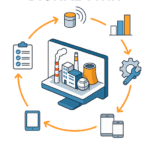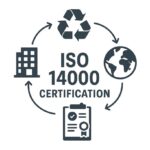Overview
Given it serves as the building block for all organic compounds, carbon is one of the most significant elements on Earth. Through its capacity to store and transport energy and nutrients between biotic (living) and abiotic (non-living) components, carbon plays a crucial function in environmental systems. Biogenic carbon, which comes from living things, and non-biogenic carbon, which comes from non-living things like fossil fuels or geological processes, are the two basic categories into which carbon may be separated. In this article, we will first define biogenic carbon and then compare it to non-biogenic carbon in terms of its origins, characteristics, and environmental impacts.
Any organic substance created by living things, such as plants or animals, via photosynthesis or respiration, is called “biologic carbon.” Due to the complex chemical structure of organic material, it has a high energy content that makes it a valuable source for both food production (such as crops) and the potential formation of fossil fuels when subjected to high temperatures over extended periods (a process known as “thermal maturation”). Due to their ancestry in living organisms that continuously cycle materials in the environment through respiration and photosynthesis cycles, biogenic forms typically have short cycle times, ranging from days to decades depending on the species types present within an ecosystem. For example, evergreen trees typically have longer cycles than deciduous ones because they retain their leaves all year long, giving them more opportunities for photosynthetic activity (s).
Non-biological forms have much longer residence times that can range from thousands to millions of years before they are incorporated into new geochemical cycles through natural processes like weathering and erosion, etc. These types are primarily produced directly or indirectly by geological-based activities like volcanism, where enormous amounts can be released quickly, or via slow, gradual accumulations that assimilate over a long period assuring their presence. Because their chemical structures are more straightforward than those of their biological counterparts, non-biological materials have much less stored energy per unit mass than their biological counterparts. There is less potential energy that can be released during combustion processes common in modern societies (such as power plants burning coal or oil, etc.).
Generalizations cannot be made because the characteristics of each type differ depending on the particular circumstances being considered, but there are trends, particularly about factors affecting the health and resilience of biodiversity: Due to their higher turnover rates than their geological counterparts—largely because of their shorter residence times—biologically based materials frequently exhibit greater diversity. In addition, because of their higher rates of nutrient replenishment, localized ecosystems can also better withstand disturbances like droughts and floods than they would be without access to such materials. attempts to mitigate climate change are also being made.
These two groups also vary in how they interact with the environment when released: The lifespan of biologically produced CO2 is typically 5 years here before it is reabsorbed back onto the land surface again, primarily through plant uptake during photosynthesis, but because this doesn’t always happen, some linger around for a lot longer still, especially if absorbed into ocean water where residence times have been recorded to be record-breaking lengths up to 30+ years. Contrarily, Nonbiological forms don’t have quite the same luxury because they typically go through chemical transformation more quickly, helping to rapidly accumulate atmospheric concentrations just a few decades after release and adding heat-trapping effects far more quickly rate, creating accelerated global warming scenarios not seen historically even recent history. This needs to be considered when considering policy decisions for future generations facing already difficult enough challenges.
Last but not least, both contribute to the total pool of resources available and should therefore be viewed as a whole rather than as separate entities to comprehend the implications related to the changes occurring because of anthropomorphic influences on day-to-day life, which are increasing of concern to a wider public consciousness and ultimately inform decisions made by governments around the world to ensure sustainability for future generations, regardless of political leanings or ideology
Summary
To summarize; contrary to popular belief, non-biological variations, despite having slower turnover rates, still quickly accumulate atmosphere, greatly increasing global warming scenarios. Biogenically sourced carbon has shorter cycling periods, allowing greater variability in terms of biodiversity health preservation while also delivering nutrient replenishment to maintain ecosystem balance. among other serious effects, increasing sea levels Everyone must bear testimony, thus serious thought must be given to all choices to maximize the benefits of whatever decisions are ultimately made on behalf of the whole population of planet Earth going ahead.
Share this:
- Click to email a link to a friend (Opens in new window) Email
- Click to share on LinkedIn (Opens in new window) LinkedIn
- Click to share on X (Opens in new window) X
- Click to share on Facebook (Opens in new window) Facebook
- Click to share on WhatsApp (Opens in new window) WhatsApp
- Click to share on Reddit (Opens in new window) Reddit
- Click to print (Opens in new window) Print
- More
- Click to share on Tumblr (Opens in new window) Tumblr
- Click to share on Threads (Opens in new window) Threads
- Click to share on Pinterest (Opens in new window) Pinterest
- Click to share on Pocket (Opens in new window) Pocket
- Click to share on Telegram (Opens in new window) Telegram
- Click to share on X (Opens in new window) X










